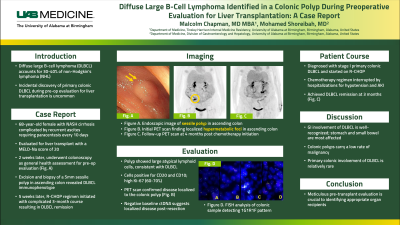Monday Poster Session
Category: Colon
P1647 - Diffuse Large B-Cell Lymphoma Identified in a Colonic Polyp During Preoperative Evaluation for Liver Transplantation: A Case Report
Monday, October 23, 2023
10:30 AM - 4:15 PM PT
Location: Exhibit Hall

Has Audio

Malcolm B. Chapman, MD
University of Alabama at Birmingham
Birmingham, AL
Presenting Author(s)
Malcolm Chapman, MD, Mohamed Shoreibah, MD
University of Alabama at Birmingham, Birmingham, AL
Introduction: Diffuse large B-cell lymphoma (DLBCL) is the most common type of non-Hodgkin's lymphoma (NHL), accounting for approximately 30-40% of all cases. DLBCL can involve extranodal sites, including the gastrointestinal tract. Although gastrointestinal involvement of DLBCL is well-documented, its discovery during preoperative evaluation for liver transplantation is uncommon. Here, we report a case of DLBCL identified incidentally in a colonic polyp during pre-transplant workup for a patient with end-stage liver disease.
Case Description/Methods: A 68-year-old female with a history of NASH cirrhosis was being evaluated for orthotopic liver transplantation due to decompensated liver function with frequent paracentesis and MELD-Na of 20. As part of the routine preoperative work-up, a colonoscopy was performed to assess for any colonic lesions that might impact posttransplant course. A 5 mm sessile polyp was found in the ascending colon and removed during the procedure. Histopathological examination of the colonic polyp revealed infiltration of large atypical lymphoid cells exhibiting a immunophenotype consistent with DLBCL. The neoplastic cells were positive for CD20 and CD10. Ki-67 labeling index was estimated at 60 to 70%, indicative of high proliferative activity. Subsequent staging investigation with positron emission tomography (PET) scan confirmed localized disease limited to the colonic polyp. Baseline ctDNA was negative, further suggesting localized disease after resection. The patient was referred to hematology-oncology for further management. Prognostic evaluation resulted in R–IPI score suggestive of good prognosis with treatment. In the absence of systemic involvement, the patient was deemed suitable for curative intent therapy with R-CHOP.
Discussion: Gastrointestinal involvement of DLBCL is well-recognized, with stomach and small intestine being the most affected sites. However, colonic involvement is relatively rare, and its discovery during preoperative evaluation for liver transplantation is even more uncommon. In this case, the patient's DLBCL was incidentally identified in a colonic polyp. It is important to note that colonic polyps are typically carry a low risk of malignancy. However, in the setting of organ transplantation, meticulous evaluation of colonic polyps becomes crucial to ensure the absence of synchronous malignancy that may complicate the post-transplant course.

Disclosures:
Malcolm Chapman, MD, Mohamed Shoreibah, MD. P1647 - Diffuse Large B-Cell Lymphoma Identified in a Colonic Polyp During Preoperative Evaluation for Liver Transplantation: A Case Report, ACG 2023 Annual Scientific Meeting Abstracts. Vancouver, BC, Canada: American College of Gastroenterology.
University of Alabama at Birmingham, Birmingham, AL
Introduction: Diffuse large B-cell lymphoma (DLBCL) is the most common type of non-Hodgkin's lymphoma (NHL), accounting for approximately 30-40% of all cases. DLBCL can involve extranodal sites, including the gastrointestinal tract. Although gastrointestinal involvement of DLBCL is well-documented, its discovery during preoperative evaluation for liver transplantation is uncommon. Here, we report a case of DLBCL identified incidentally in a colonic polyp during pre-transplant workup for a patient with end-stage liver disease.
Case Description/Methods: A 68-year-old female with a history of NASH cirrhosis was being evaluated for orthotopic liver transplantation due to decompensated liver function with frequent paracentesis and MELD-Na of 20. As part of the routine preoperative work-up, a colonoscopy was performed to assess for any colonic lesions that might impact posttransplant course. A 5 mm sessile polyp was found in the ascending colon and removed during the procedure. Histopathological examination of the colonic polyp revealed infiltration of large atypical lymphoid cells exhibiting a immunophenotype consistent with DLBCL. The neoplastic cells were positive for CD20 and CD10. Ki-67 labeling index was estimated at 60 to 70%, indicative of high proliferative activity. Subsequent staging investigation with positron emission tomography (PET) scan confirmed localized disease limited to the colonic polyp. Baseline ctDNA was negative, further suggesting localized disease after resection. The patient was referred to hematology-oncology for further management. Prognostic evaluation resulted in R–IPI score suggestive of good prognosis with treatment. In the absence of systemic involvement, the patient was deemed suitable for curative intent therapy with R-CHOP.
Discussion: Gastrointestinal involvement of DLBCL is well-recognized, with stomach and small intestine being the most affected sites. However, colonic involvement is relatively rare, and its discovery during preoperative evaluation for liver transplantation is even more uncommon. In this case, the patient's DLBCL was incidentally identified in a colonic polyp. It is important to note that colonic polyps are typically carry a low risk of malignancy. However, in the setting of organ transplantation, meticulous evaluation of colonic polyps becomes crucial to ensure the absence of synchronous malignancy that may complicate the post-transplant course.

Figure: Fluorescence in situ hybridization (FISH) analysis was performed using a dual color BCL6 break apart probe set that detected the signal pattern (1R1G1F) commonly associated with B-cell lymphoma.
Disclosures:
Malcolm Chapman: CVS Health – Employee.
Mohamed Shoreibah indicated no relevant financial relationships.
Malcolm Chapman, MD, Mohamed Shoreibah, MD. P1647 - Diffuse Large B-Cell Lymphoma Identified in a Colonic Polyp During Preoperative Evaluation for Liver Transplantation: A Case Report, ACG 2023 Annual Scientific Meeting Abstracts. Vancouver, BC, Canada: American College of Gastroenterology.
